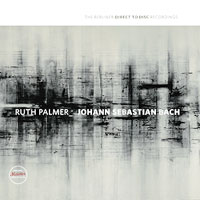Ruth Palmer • Johann Sebastian Bach
 he
LP jacket has little in terms of musical information, but the back cover has much to
excite the audiophile. Ruth Palmer is shown in the famous Meistersaal of Emil Berliner
Studios playing her violin in front of a small forest of microphone stands. Besides noting
recording engineers and producers, Berliner Meister Schallplatten (BMS) lists the
equipment used for these recordings: DGG microphone preamps, ADT mixers, a Gyratec G23
(which can be used to apply a bass boost/cut or treble boost/cut similar to Quad’s
tilt knob on their preamps); Neumann lathes and cutter heads, and Ortofon amps are used in
the cutting process, with Pallas creating the lacquers. The Josephson C722 mics used were
developed specifically for BMS recordings, and Palmer’s website reports that these
mics were flown in from California just three days before the first recording session.
"From the microphone to the final vinyl disc, the audio signal stays analogue,
without compromise." This quote comes from the BMS website. And, true to this
commitment to quality, all BMS recordings are recorded direct-to-disc and are exclusively
distributed by Speakers Corner. he
LP jacket has little in terms of musical information, but the back cover has much to
excite the audiophile. Ruth Palmer is shown in the famous Meistersaal of Emil Berliner
Studios playing her violin in front of a small forest of microphone stands. Besides noting
recording engineers and producers, Berliner Meister Schallplatten (BMS) lists the
equipment used for these recordings: DGG microphone preamps, ADT mixers, a Gyratec G23
(which can be used to apply a bass boost/cut or treble boost/cut similar to Quad’s
tilt knob on their preamps); Neumann lathes and cutter heads, and Ortofon amps are used in
the cutting process, with Pallas creating the lacquers. The Josephson C722 mics used were
developed specifically for BMS recordings, and Palmer’s website reports that these
mics were flown in from California just three days before the first recording session.
"From the microphone to the final vinyl disc, the audio signal stays analogue,
without compromise." This quote comes from the BMS website. And, true to this
commitment to quality, all BMS recordings are recorded direct-to-disc and are exclusively
distributed by Speakers Corner.
But great recording gear and pedigree don’t guarantee a performance worth hearing. How does this release compare to other great recordings? Let’s consider two: Nathan Milstein’s mid-1970s JS Bach: Sonatas and Partitas [Deutsche Grammophon 423 294] and Hilary Hahn’s debut, Hilary Hahn Plays Bach [Sony Classical 62793]. On the Partita for Solo Violin No. 3 in E major, BWV1006, both Milstein and Hahn perform with rhythmic precision that is sometimes referred to as "motoric rhythm." Late-Baroque composers like Vivaldi and Bach used a constant eighth-note pulse in their faster movements to give the impression that "the music is propelled by little motors," as my college music-history professor would say. Milstein’s performance is virtuosic, with a sense that he is barely restraining his formidable technique. Hahn’s version is a marvel of precision, and her impeccable tuning lets Bach’s music shine through. Palmer presents a different view of the Partita, particularly the opening Preludio. In opposition to Hahn’s perfect timing, Palmer lets the pulse speed up and slow down as she interprets each phrase. Endings of the phrases frequently slow down, only to return with extra rhythmic energy as she plays the next phrase. It feels more like she is playing in an intimate chamber recital for friends instead of a formal concert. Palmer refuses to play Bach with mechanical perfection instead looking for the human qualities of the melodies. The enhanced sonics of the BMS recording reinforce the humanness of her performance. In contrast to Milstein or Hahn, Palmer’s take on the Sonata is somber and austere. She plays with a sense of loss or remorse, as if Bach had suffered a tragedy in his life while composing this piece. While interesting, one might wish for some emotional release in the Sonata’s livelier dance movements. The sound? In a word, glorious. It’s doubtful that you own a violin recording that is closer to the true timbre than this one. Palmer’s tone is dark and sumptuous. You can hear open strings resonating sympathetically with played strings, and the resonance of the violin body is clearly heard in slower movements. Double stops are fascinating; each finger has a slightly different vibrato, something I’ve not heard before. For even greater hedonistic pleasure, listen with headphones for a point-of-view perspective that has become my favorite mode of listening to this great recording. The only recording distraction occurs in the Sonata. The first movement begins with a rumbling sound followed by the violin tone emerging from that rumble. A quick check of the album jacket reveals that it was recorded at an earlier date with a different engineer, and I assume the rumble is from the HVAC system. Fortunately, it is not too obtrusive except in the quietest sections. By contrast, the Partita is completely quiet. I recommend this recording for Ruth Palmer’s
performance, the incredible beauty of her violin tone, and excellent sonics throughout. |
